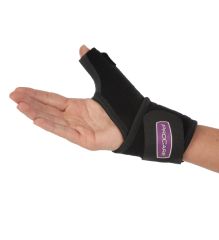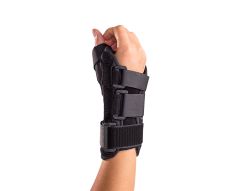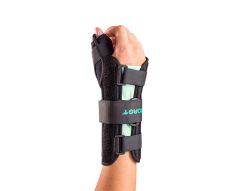Thumb Arthritis
Though you may not be aware of it, your thumb is responsible for 50-60% of all our hand functions. When the base of the thumb becomes inflamed or irritated, the condition is called thumb arthritis, which is also known as basal joint arthritis or carpometacarpal arthritis. There are many different types of arthritis that can exist throughout the body, but when the thumb is involved, it’s usually osteoarthritis. This is a gradual, wear-and-tear type of arthritis that usually comes about from the aging process.
What Causes Thumb Arthritis?
The joint at the base of the thumb is called the basal or carpometacarpal joint. This joint is extremely important, as it provides stability to the thumb and allows it swivel, pivot and pinch. As a result, the basal joint gets lots of use because it’s so central to many hand movements, and this makes it more likely to be damaged from wear and tear. The ends of the bones that connect to form the basal joint are surrounded by articular cartilage, which allows the bones to glide smoothly against each other and protects them from touching. Osteoarthritis occurs when this cartilage begins to thin and wear away, which roughens this smooth surface. Eventually, the bones will start rubbing against one another, causing pain and damage the basal joint.
Osteoarthritis also known as OA is a degenerative condition, meaning it usually develops gradually over the course of time. Older age and female gender are two of the biggest risk factors, as women over the age of 40 are more likely to get osteoarthritis of the thumb than any other group. Activities and jobs that regularly put high amounts of stress on the basal joint are also at a higher risk for developing it. Obesity, genetics and injuries to the thumb—like fractures and sprains—may add to the risk as well.
Though thumb arthritis usually means osteoarthritis, there are some rare cases in which rheumatoid arthritis is responsible. Rheumatoid arthritis is generally more likely to occur in the wrist or other fingers than the thumb.
What are the Symptoms?
The first and most common symptom of thumb arthritis is pain at the base of the thumb. This pain will typically occur or get worse when you attempt to grip, grasp or pinch an object, or when you use your thumb to apply force. Turning a key, opening a doorknob or jar and snapping are all activities that often lead to pain. Other symptoms may include swelling, stiffness, warmth, tenderness or general discomfort. Patients may also experience weakness and limited ability to move the thumb normally, especially when grasping or pinching. As a result, it can become very difficult to perform many daily activities.
What is the Treatment?
If you’ve been experiencing pain and other symptoms of thumb arthritis that have not improved after a while, it’s best to see a doctor or physical therapist. In order to reach a diagnosis, they will perform a complete evaluation by taking down your history, performing an examination, and assessing your thumb function. X-rays are not usually needed, but they are given in some cases as well. If it’s found that you have thumb arthritis, your doctor or physical therapist will most likely recommend conservative (non-surgical) home remedies. This will usually consist of:
- Ice: apply ice or a cold compress to the base of the thumb for 10-15 minutes, a few times a day to relieve swelling and pain
- Adaptive equipment: there are a number of products available—like jar openers, key turners and large zipper pulls—that can be helpful if you have limited hand strength and function
Physical Therapy
In addition to these home remedies, a physical therapist can offer further guidance and provide you with more specific treatments to address your symptoms, such as:
Splinting/bracing with compression
Your physical therapist might suggest wearing a brace or splint to limit the movement of the thumb and allow the joint to rest and heal; it should support and compress both the wrist and thumb and be worn at night and during any time symptoms get worse to help alleviate pain; the ProCare Universal Thumb-O-Prene and DonJoy ComfortForm Wrist and Thumb Support are both ideal for this purpose.
Passive therapies
These are therapies performed on the patient by the therapist, and may include manual therapy, massage, ultrasound and ice or heat therapy.
Active stretching and strengthening exercises
These exercises are performed by the patient to increase flexibility and strength; therapeutic tape, putty and/exercise balls may be used in some of these exercises.
Education/activity modification
Your therapist will also educate you on your condition and help you make adjustments in your daily routine to reduce pain.
Injections
If these treatments aren’t effective and symptoms continue to be bothersome, your doctor or physical therapist may recommend a corticosteroid injection; this is an anti-inflammatory medication injected directly into the joint that will temporarily relieve pain for a few months
Surgery
If your thumb arthritis still doesn’t improve after trying all available conservative treatments or you can barely move your thumb, surgery may be needed. The main surgical options are having the joint removed and replaced, removing one of the bones in the thumb joint, or fusing two bones together. A cast or splint must be worn for up to six weeks after surgery, and a rehabilitation program will be needed as well.
Can Thumb Arthritis Be Prevented?
Just like with any other type of OA, there are some risk factors like age, gender and genetics that are out of our control. But this does not mean there’s nothing you can do to prevent thumb arthritis. Here are some ways you can reduce your chances of developing it:
- Use larger, stronger joints when they are available, and try to avoid pinching or grasping for a long period of time
- Use pens with large diameters or pen grips so you’re not straining your thumb when writing
- Try using specialized tools or adaptive equipment in the kitchen and the yard that will help reduce the amount you use your thumb
- Follow a thumb exercise program to build strength and flexibility in and around the thumb joint; a physical therapist can help guide you through one of these programs







